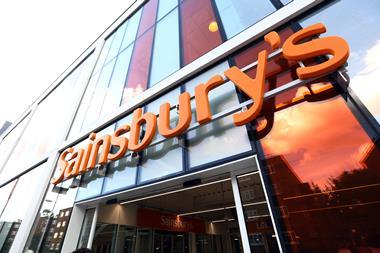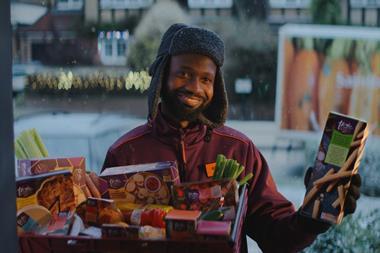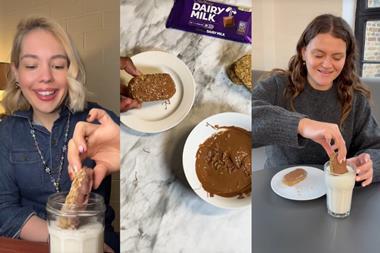If out of stocks are a headache for customers, they create a migraine for online pickers as deputy editor Siân Harrington found out. She spent the day as a Sainsbury picker in the first of a new series in which members of The Grocer team trade places with our readers and head ‘back to the floor’
It’s 10am on a busy Friday in Sainsbury’s West Hove store and I am being briefed on the day ahead. To the initiated, it’s obvious I’m not your typical new staffer - after all, how many new colleagues get to sit down for a coffee with head of Sainsbury’s Online Toby Anderson, on his first anniversary in the role, and store manager Ronan Phelan?
But, having donned my Sainsbury uniform, I am hoping I will be able to blend in when I step on to the shopfloor as the newest picking recruit.
The choice of Sainsbury’s West Hove store is fitting. It’s a year this month since the store introduced the service and, according to Phelan, it’s been a great success. “We are doing 250 orders a week and intend to increase this to 600 over the next 12 months. We now have a solid grounding and I would now like to expand the service to a greater geographical area,” he says.
The store has a dedicated team of Sainsbury’s to You (or STY as they call it) personnel, headed by STY manager Anna Blunden. A checkout supervisor just 12 months ago, Blunden looks after 18 staff including part-timers and those covering the late shift. However, a total of 45 staff members are trained to cover pickers and drivers in case of holidays or sickness.
Out back, in the STY area, she explains how to pull off the order from the central computer. “The orders for today came over yesterday and we started picking last night for the early deliveries. These have a 9am cut-off time,” she says.
“The orders are stored centrally so that the customer can change it right up to the picking time - and they frequently do. But we can see them well in advance to check we have the lines in.”
This also gives Blunden the opportunity
to see if there is anything unusual. And to prove the point, up pops an order for 20 items from just two lines at a cost of £82.20. On further investigation it comprises two varieties of wine.
“I speak to the department manager and check we have stock. We have one customer who always orders non-alcoholic cider so I put a case by when the delivery comes in,” Blunden says, pulling off my first order.
I have been assigned ambient. Earlier this year Sainsbury rolled out zone-based picking in a multi-million pound initiative that involved new equipment and the re-training of 2,500 staff. The idea is that staff become specialists in a category, enabling them to find products quickly and make better substitutions.
My order comprises 27 lines and 94 items. It is 12.11pm and the target is to get it done by 1.03. Pushing my trolley, with a selection of totes (crates), a handheld scanning device and seasoned online picker Lesley Potter in tow, I set off.
“Ambient usually starts in aisle 6 so I tend to turn left into the store,” says Potter. It’s tips like this you need when navigating a 52,000 sq ft store. I look at the scanner, which automatically shows the next item and where it is located. Petit pois 410g, aisle 8, on the right, block four - two packs. When I find them I scan a tote, which gets assigned to the customer, scan the petit pois and in they go.
Up comes the next item - French green beans. First problem: there are different types of green beans. So I press for more information. I’m looking for very fine, continental choice 400g and there they are.
Five products later and I realise this is a great way of getting fit as I trek over to aisle 18 - I should have worn a pedometer.
It’s here I get my first out of stock: Hovis premium white loaf, thick sliced 800g. Potter checks with a department colleague - there has not been a delivery. So we type ‘out of stock’ into the scanner and a potential substitution appears - Hovis premium medium. Time for a discussion. Would this shopper prefer the same line, medium sliced, or another Hovis variety thick sliced? We decide on Hovis Square thick cut and put it in the crate.
Many online customers at West Hove are regulars and the pickers get to know their orders. By now Potter has worked out the identity of this one. “If it’s the kiosk next it must be 11 packs of Silk Cut,” she says. “Then it will be two avocados.” She is right.
At the kiosk I have to sign to say I had received the cigarettes. Then, searching through avocados, Potter is unhappy with a sell-by date of three days’ time. “I like to find one that has a long date,” she says, asking a department colleague if there are any out back. While she goes to check we move on.
At the end of the order it reverts to avocados and, having secured two with later dates, I go to the back of store to complete the pick. Here each tote is scanned, the name of the customer pops up and is written on the side of the crate with the delivery time -
in this case 16.01. It also shows in which of four lanes to park the trolley.
Flushed from the success of completing within the time limit I go out again, this time to pick chilled. There are four different customers on one order. Each time a new customer comes up I scan a new tote.
Half way round and I find myself picturing the recipient of each shop. “That must belong to Shopper A,” I say, as Potter picks up a particular brand of spread - and indeed it does. Shopper A, I have decided, is the mother of a demanding family of boys who watches the pennies. On the other hand, Shopper B is a young, single man who likes the good things in life and entertains a lot, I decide, as I search for his organic pork fillets. Guessing customers’ lifestyles is one of the fun things about the job, admits Potter, who picks from 7am-2pm.
At the end of my day I am convinced the key to online picking is to employ staff who do their own food shopping. Retailers put much effort into delivery and the ordering process but with availability issues dogging the industry it’s the store picker who has to get into the mind of the shopper and choose the best substitution.
It’s 10am on a busy Friday in Sainsbury’s West Hove store and I am being briefed on the day ahead. To the initiated, it’s obvious I’m not your typical new staffer - after all, how many new colleagues get to sit down for a coffee with head of Sainsbury’s Online Toby Anderson, on his first anniversary in the role, and store manager Ronan Phelan?
But, having donned my Sainsbury uniform, I am hoping I will be able to blend in when I step on to the shopfloor as the newest picking recruit.
The choice of Sainsbury’s West Hove store is fitting. It’s a year this month since the store introduced the service and, according to Phelan, it’s been a great success. “We are doing 250 orders a week and intend to increase this to 600 over the next 12 months. We now have a solid grounding and I would now like to expand the service to a greater geographical area,” he says.
The store has a dedicated team of Sainsbury’s to You (or STY as they call it) personnel, headed by STY manager Anna Blunden. A checkout supervisor just 12 months ago, Blunden looks after 18 staff including part-timers and those covering the late shift. However, a total of 45 staff members are trained to cover pickers and drivers in case of holidays or sickness.
Out back, in the STY area, she explains how to pull off the order from the central computer. “The orders for today came over yesterday and we started picking last night for the early deliveries. These have a 9am cut-off time,” she says.
“The orders are stored centrally so that the customer can change it right up to the picking time - and they frequently do. But we can see them well in advance to check we have the lines in.”
This also gives Blunden the opportunity
to see if there is anything unusual. And to prove the point, up pops an order for 20 items from just two lines at a cost of £82.20. On further investigation it comprises two varieties of wine.
“I speak to the department manager and check we have stock. We have one customer who always orders non-alcoholic cider so I put a case by when the delivery comes in,” Blunden says, pulling off my first order.
I have been assigned ambient. Earlier this year Sainsbury rolled out zone-based picking in a multi-million pound initiative that involved new equipment and the re-training of 2,500 staff. The idea is that staff become specialists in a category, enabling them to find products quickly and make better substitutions.
My order comprises 27 lines and 94 items. It is 12.11pm and the target is to get it done by 1.03. Pushing my trolley, with a selection of totes (crates), a handheld scanning device and seasoned online picker Lesley Potter in tow, I set off.
“Ambient usually starts in aisle 6 so I tend to turn left into the store,” says Potter. It’s tips like this you need when navigating a 52,000 sq ft store. I look at the scanner, which automatically shows the next item and where it is located. Petit pois 410g, aisle 8, on the right, block four - two packs. When I find them I scan a tote, which gets assigned to the customer, scan the petit pois and in they go.
Up comes the next item - French green beans. First problem: there are different types of green beans. So I press for more information. I’m looking for very fine, continental choice 400g and there they are.
Five products later and I realise this is a great way of getting fit as I trek over to aisle 18 - I should have worn a pedometer.
It’s here I get my first out of stock: Hovis premium white loaf, thick sliced 800g. Potter checks with a department colleague - there has not been a delivery. So we type ‘out of stock’ into the scanner and a potential substitution appears - Hovis premium medium. Time for a discussion. Would this shopper prefer the same line, medium sliced, or another Hovis variety thick sliced? We decide on Hovis Square thick cut and put it in the crate.
Many online customers at West Hove are regulars and the pickers get to know their orders. By now Potter has worked out the identity of this one. “If it’s the kiosk next it must be 11 packs of Silk Cut,” she says. “Then it will be two avocados.” She is right.
At the kiosk I have to sign to say I had received the cigarettes. Then, searching through avocados, Potter is unhappy with a sell-by date of three days’ time. “I like to find one that has a long date,” she says, asking a department colleague if there are any out back. While she goes to check we move on.
At the end of the order it reverts to avocados and, having secured two with later dates, I go to the back of store to complete the pick. Here each tote is scanned, the name of the customer pops up and is written on the side of the crate with the delivery time -
in this case 16.01. It also shows in which of four lanes to park the trolley.
Flushed from the success of completing within the time limit I go out again, this time to pick chilled. There are four different customers on one order. Each time a new customer comes up I scan a new tote.
Half way round and I find myself picturing the recipient of each shop. “That must belong to Shopper A,” I say, as Potter picks up a particular brand of spread - and indeed it does. Shopper A, I have decided, is the mother of a demanding family of boys who watches the pennies. On the other hand, Shopper B is a young, single man who likes the good things in life and entertains a lot, I decide, as I search for his organic pork fillets. Guessing customers’ lifestyles is one of the fun things about the job, admits Potter, who picks from 7am-2pm.
At the end of my day I am convinced the key to online picking is to employ staff who do their own food shopping. Retailers put much effort into delivery and the ordering process but with availability issues dogging the industry it’s the store picker who has to get into the mind of the shopper and choose the best substitution.


















No comments yet